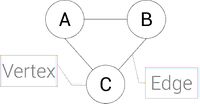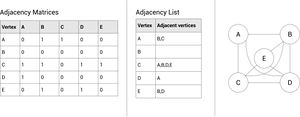Graphs
Contents
TRC PowerPoint
What is a graph
A graph is an abstract data structure. It can be used to solve routine problems.
Vertices connected by an edge (see picture) are called Neighbours.
The degree of a vertex is how many things are connected to it, in the picture, there would be 2.
Edges can also be called connectors and vertex can also be called nodes or entries.
https://www.youtube.com/watch?v=PMPMDZqeipw&list=PLCiOXwirraUD0G290WrVKpVYd3leGRRMW&index=7
Terms
weighted graph
Each edge/arc has an associated value, which can be used for distance, cost and so on.
vertex/node
An entity, location within the graph (represented by a circle).
edge/arc
A connection between two vertex/nodes
undirected graph
You can travel either direction on an edge/arc. For example an edge between A & B allows movement from A to B and from B to A.
directed graph
Each edge/arc will have an arrow to indicate the direction of travel. This will require additional edges to cover both directions.
Adjacency List
An adjacency matrix is a list showing the what vertexes are connected to their neighbors. This is represented by a list showing what vertex is connected to the other.
Adjacency Matrix
This is a list shown in binary for the values that are going to be connected. It usually helps to transfer the matrices into a list first before you turn it into a graph to make things easier.
Comparison of List VS Matrix
| List | Matrix |
|---|---|
| Its quicker to find an edge | Needs to look at all items |
| Less space, no wastage | Stores information about each edge |



